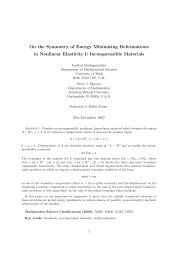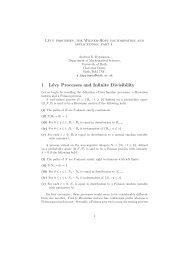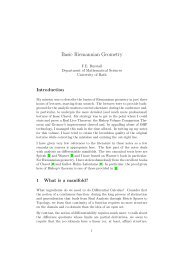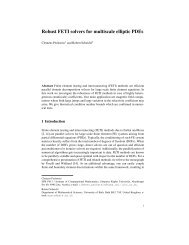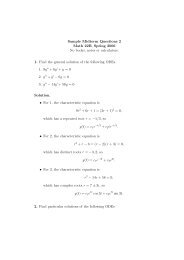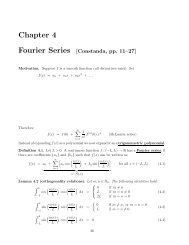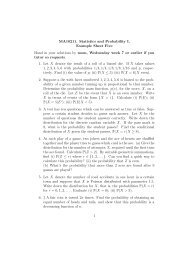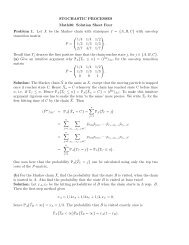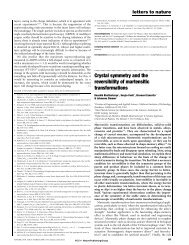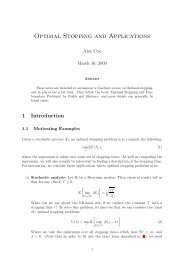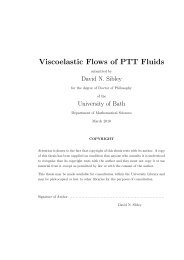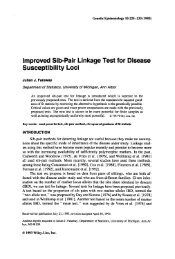MA10211. Statistics and Probability I. Example Sheet Six Hand in ...
MA10211. Statistics and Probability I. Example Sheet Six Hand in ...
MA10211. Statistics and Probability I. Example Sheet Six Hand in ...
You also want an ePaper? Increase the reach of your titles
YUMPU automatically turns print PDFs into web optimized ePapers that Google loves.
<strong>MA10211.</strong> <strong>Statistics</strong> <strong>and</strong> <strong>Probability</strong> I.<br />
<strong>Example</strong> <strong>Sheet</strong> <strong>Six</strong><br />
H<strong>and</strong> <strong>in</strong> your solutions by noon, Wednesday week 8 or earlier if you<br />
tutor so requests.<br />
1. Suppose each page of a typed article conta<strong>in</strong>s at least one mistake with<br />
<strong>in</strong>dependent probability p. Let X be the total number of pages with<br />
mistakes on them <strong>in</strong> an n page article. State the exact distribution<br />
for X <strong>and</strong> the average number of pages <strong>in</strong> the article that conta<strong>in</strong><br />
mistakes, E(X). If n is large <strong>and</strong> p small, state an approximation for<br />
the distribution of X<br />
Suppose, on average, a typist makes mistakes on one <strong>in</strong> every 60 pages.<br />
In a 20 page article, f<strong>in</strong>d the exact probability there are (i) no mistakes<br />
(ii) at least two mistakes. Re-calculate these probabilities us<strong>in</strong>g the<br />
approximation. Is the approximation any good here<br />
2. Professor U.N.Ethical conducted the follow<strong>in</strong>g cruel experiment: A rat<br />
has to choose between four similar doors, only one of which is ‘correct’.<br />
A correct choice is rewarded with food <strong>and</strong> an <strong>in</strong>correct choice is punished<br />
by a small electric shock. If an <strong>in</strong>correct choice is made, the rat is<br />
returned to the start<strong>in</strong>g-po<strong>in</strong>t <strong>and</strong> chooses aga<strong>in</strong>, this cont<strong>in</strong>u<strong>in</strong>g until<br />
the correct response is made. The food is not moved between successive<br />
trials. Let the r<strong>and</strong>om variable X be the number of trials required<br />
until the first correct response is made, X thus tak<strong>in</strong>g values 1, 2, . . . .<br />
F<strong>in</strong>d the distribution <strong>and</strong> mean of X under the follow<strong>in</strong>g different hypotheses:<br />
(i) each door is equally likely to be chosen on each trial, <strong>and</strong><br />
all choices are made <strong>in</strong>dependently of others; (ii) the rat chooses with<br />
equal probability between the doors that have not so far been tried, no<br />
choice ever be<strong>in</strong>g repeated; (iii) ∗ the rat never chooses the same door<br />
on two successive trials, but otherwise chooses at r<strong>and</strong>om with equal<br />
probabilities. [Check: Means are (i) 4 (ii) 2.5 (iii) 3 1 4 .]<br />
3. Let Y be the score on roll<strong>in</strong>g a fair die. Write down the distribution of<br />
Y . Calculate E(Y ), E(Y 2 ) <strong>and</strong> E(α Y ), where α is some constant.<br />
If X is a discrete r<strong>and</strong>om variable with P(X = i) = 1/n for each<br />
i ∈ {1, 2, . . . , n} then X is said to have the discrete uniform distribution<br />
on the set {1, 2, . . . , n}, written X ∼ Unif{1, 2, . . . , n}. Calculate<br />
1
E(X), E(X 2 ) <strong>and</strong> E(α X ), simplify<strong>in</strong>g your expressions <strong>in</strong> each case.<br />
[H<strong>in</strong>t: Recall, 1 2 + 2 2 + 3 2 + · · · + n 2 = n(n + 1)(2n + 1)/6.]<br />
4. A penny is tossed four times. Let X be the number of tails <strong>in</strong> the first<br />
two tosses <strong>and</strong> let Y be the number of tails <strong>in</strong> the last two tosses.<br />
F<strong>in</strong>d the distribution of X <strong>and</strong> the distribution of Y . Deduce, with<br />
reasons, the jo<strong>in</strong>t distribution for (X, Y ).<br />
Let Z to be the number of tails <strong>in</strong> the last three tosses. F<strong>in</strong>d the jo<strong>in</strong>t<br />
distribution of (X, Z) [H<strong>in</strong>t: its easiest to draw a table of probabilities,<br />
check they add to 1]. F<strong>in</strong>d the marg<strong>in</strong>al distribution of Z. Show that<br />
X <strong>and</strong> Z are dependent RVs.<br />
F<strong>in</strong>d the conditional distribution of X given that Z = 3, that is the<br />
probabilities P(X = i | Z = 3).<br />
5. Suppose that discrete r<strong>and</strong>om variables X, Y have jo<strong>in</strong>t distribution<br />
P(X = x; Y = y) = k(x + y) for x ∈ {0, 1, 2}, y ∈ {1, 2, 3}, where k is<br />
a suitable constant. F<strong>in</strong>d the value of k.<br />
F<strong>in</strong>d the marg<strong>in</strong>al distributions for X <strong>and</strong> Y . Are X <strong>and</strong> Y <strong>in</strong>dependent<br />
r<strong>and</strong>om variables<br />
Calculate E(X) <strong>and</strong> E(Y ). Deduce E(2X + 3Y + 4) <strong>and</strong> E(X − Y ).<br />
Calculate E(X − Y ) directly from the jo<strong>in</strong>t distribution us<strong>in</strong>g the ‘law<br />
of the unconscious statistician’ <strong>and</strong> verify that this agrees with your<br />
previous answer.<br />
By a suitable summation, calculate P(X ≥ Y ).<br />
6. Flaws <strong>in</strong> the plat<strong>in</strong>g of large sheets of metal occur at r<strong>and</strong>om with, on<br />
the average, one <strong>in</strong> each section of area 10m 2 . What is the probability<br />
that a sheet 5m by 8m will have no flaws At most one flaw An even<br />
number of flaws ∗ <br />
http://www.maths.bath.ac.uk/∼ak257/probstat1.html<br />
2



